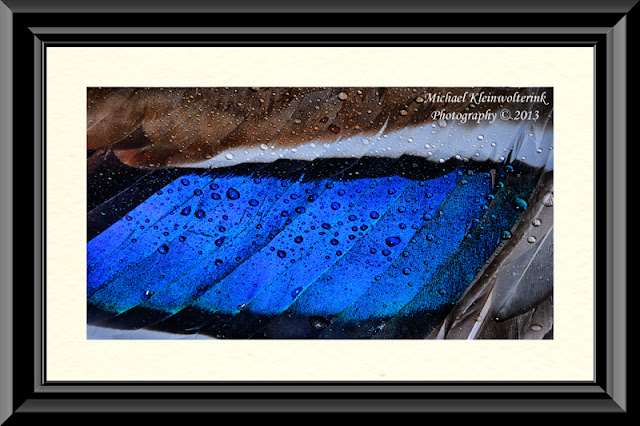For this shooting session, I was in my basement with the lights off and
the D90 mounted on my Slik tripod to make sure I could get the sharpest image
possible. To be able to focus closer on the wing, I put a 20mm extension tube
on the 18-105mm. Camera settings included an aperture of f11, f13 or f36, ISO 200,
RAW format and self timer. The VR was turned off on the lense and I focused
manual using the live view feature on the D90. To light the wing tip, I
handheld the SB-700 SpeedLight at different angles along with changing the
flash power output from 1/1 to 1/64.
Once in ViewNX, I made adjustments to the RAW files by adjusting the
following: white balance, picture control and highlight/shadows. I changed the
white balance to direct sunlight while the picture control was adjusted to the
custom nature/landscape. To help control the whites and the blacks, I adjusted
the highlight and shadow sliders if necessary.
I also created HDR images with some of the images so when doing that, I
created five different exposed images by ranging the exposure compensation on
the RAW files from -1.5 to 1.5. I then outputted those files into 16 bit Tiff’s
and worked on them in EasyHDR 2.0. I used the standard settings of black and
white, night and dramatic in their drop down list of effects.
The final step was using PhotoShop Elments 11 to crop, sharpen and
enhance the images using special effects. I used layer masks and the brush tool
to create new images by brushing out the areas that I wanted to be seen through
the background image. With the water droplets, I used a small brush tool to
allow the blue of the mallard wings to shine through the rest of the wing which
was black and white; It took me roughly an hour to brush out all the droplets. I
also used the VirtualPhotographer plugin to change the black and white images
into a world war II type b/w. Lastly, I duplicated the main layer for the image
and sharpened that layer using the high pass sharpen filter and changed the
blend mode to overlay and adjusted the opacity to around 20%.
Up next I hope will be scenes from snow goose hunting and I hopefully
will be testing out a new Nikon lense. I’ve sent my Sigma 50-150 in on a trade
and looking at a Nikon 24-120 f4 instead. When reviewing the lenses, the new
Nikon D7100 body was announced which made me think about spending money on a
new body too. But I then looked at the specs and the RAW buffer size on the
D7100 is alittle slow for me shooting RAW all the time. I'll await the hopefully release of a D300s replacement in the coming months or years.
#1.
#2.
#3.
#4.
#5.
#6.
#7.
#8.
#9.
#10. HDR Processed.
#11. Cross between HDR b/w & HDR color with layer mask.
#12.
#13.
#14.
#15.
#16.
#17. HDR B/W Processed with Layer Mask for water droplets.
#18. WWII B/W from Virtual Photographer with Layer Mask for water droplets.
#19.
#20. HDR Processed.
#21.
#22. Cross between b/w and color processing with layer mask for water droplets & call.





















